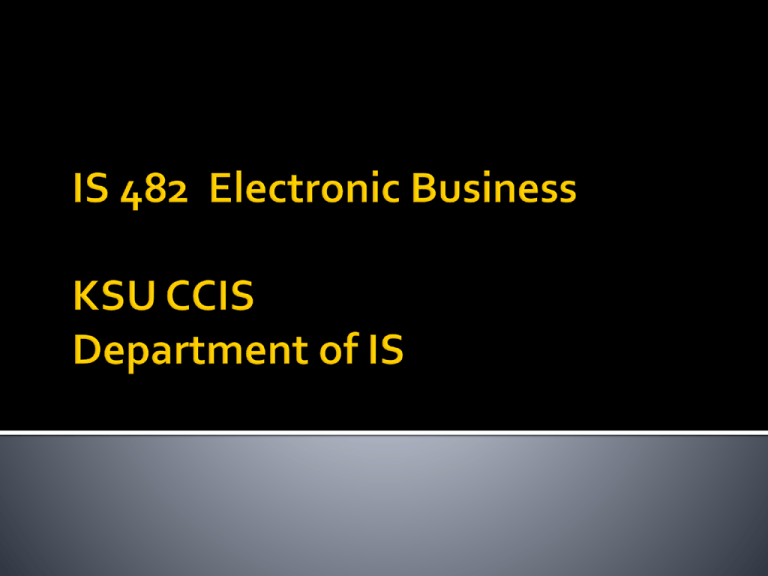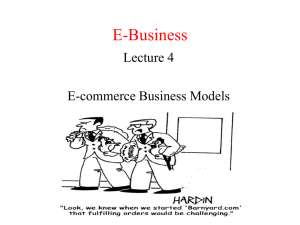Electronic Business IS 482 KSU CCIS Department of IS
advertisement

E-commerce Business Technology Society seventh edition 2011 Kenneth C. Laudon Carol Guercio Traver Chapter 1 Introduction and Overview Electronic Commerce (E-Commerce, or EC) is a concept that describes the process of buying and selling or exchanging of products, services, and information via computer networks including the Internet. EC can be defined from the following perspectives: From a communication perspective, EC is the delivery of information, products/services, or payments over telephone lines, computer networks, or any other electronic means. From a business process perspective, EC is the application of technology toward the automation of business transactions and work flow. From a service perspective, EC is a tool that addresses the desire of firms, consumers, and management to cut service costs while improving the quality of goods and increasing the speed of service delivery. From an online perspective, EC provides the capability of buying and selling products and information on the internet and other online services. E-commerce covers outward-facing processes that touch customers, suppliers and external partners, including sales, marketing, order taking, delivery, customer service, purchasing of raw materials and supplies for production and procurement of indirect operating-expense items, such as office supplies. It involves new business models and the potential to gain new revenue or lose some existing revenue to new competitors. E-business includes E-commerce but also covers internal processes such as production, inventory management, product development, risk management, finance, knowledge management and human resources. E-business strategy is more complex, more focused on internal processes, and aimed at cost savings and improvements in efficiency, productivity and cost savings. E-commerce technology is different, more powerful than previous technologies E-commerce bringing fundamental changes to commerce Traditional commerce: Passive consumer Sales-force driven Fixed prices Information asymmetry 1. 2. 3. 4. 5. 6. 7. 8. Ubiquity Global reach Universal standards Information richness Interactivity Information density Personalization/customization Social technology Technologies that allow users to: Create and share content, preferences, bookmarks, and online personas Participate in virtual lives Build online communities ▪ E.g. Twitter, YouTube, Facebook, Second Life, Wikipedia, Digg EC applications started in the early 1970s, with such innovations as electronic fund transfer(EFT). It was limited to large corporations, financial institutions, and few small businesses. Then came Electronic Data Interchange, which enlarged the participating companies to manufacturers, retailers, services and so on. Many other applications followed, ranging from stock trading to travel reservation systems. Such systems were described as telecommunication applications and their value was widely recognized. With the commercialization of the Internet in the early 1990s and its rapid growth to millions of potential customers, the term EC was coined and its applications was expanded rapidly. One reason for this rapid expansion was the development of networks, protocols, software, and specifications. Almost every medium and large sized organizations in developed countries has a web site. 1995-2000: Innovation Key concepts developed Dot-coms; heavy venture capital investment 2001-2006: Consolidation Emphasis on business-driven approach 2006-Present: Reinvention Extension of technologies New models based on user-generated content, social networks, services Many people think EC is just having a Web site, but it is much more that. There are dozens of applications of EC such as home banking, shopping in online stores, buying stocks, finding a job, conducting an auction, and collaborating electronically on research and development projects. To execute these applications, it is necessary to have supporting information and organizational infrastructure and systems. Infrastructure is dependent on four major areas: people, public policy, technical standards and other organizations. Classified by market relationship Business-to-Consumer (B2C) Business-to-Business (B2B) Consumer-to-Consumer (C2C) Classified by technology used Peer-to-Peer (P2P) Mobile commerce (M-commerce) Electronic markets: Buying and selling goods and services. Inter-organizational systems (IOS) Facilitating inter and intra-organization flow of information, communication and collaboration. Providing customer service. Electronic Markets An Electronic market is not a physical building but rather a network-based location where business interactions occur. It is a place where the shoppers and sellers meet. Inter-organizational Information Systems (IOS) An IOS involves information flow among two or more organizations. Its major objective is efficient transaction processing, such as transmitting orders, bills and payments using EDI. All relationships are predetermined: there is no negotiation, just execution. In contrast, in electronic markets, sellers and buyers negotiate, submit bids, agree on an order, and finish the execution on- or offline. IOS are used for B2B applications, whereas electronic markets exist in both B2B and B2C cases. The types of IOS are as follows: Electronic data interchange (EDI) Extranets Electronic funds transfer Electronic forms Integrated messaging Shared databases Supply chain management Business-to-business (B2B). It includes the IOS and electronic market transactions between organizations. Most of EC today is of this type. Business-to-consumer (B2C). These are retailing transactions with individual shoppers that is consumer or customer. Consumer-to-consumer (C2C). In this category, consumer sells directly to consumers. Examples are selling residential property, cars, and so on. Advertising personal services and auctions are examples of C2C as well. Consumer-to-business (C2B). It includes individuals who sell products or services to organizations. Non-business EC. An increased number of non-business institutions such as academic institutions, not-for-profit organizations, religious organizations, social organizations, and government agencies are using various types of EC to reduce their expanses or to improve their operations and customer service. Intra-business (organizational) EC. In this category we include all internal organizational activities, usually performed on intranets, that involve exchange of goods, services, or information. Activities range from selling corporate products to employees to online training and cost-reduction activities. Benefits to Organizations Global reach Cost reduction Supply chain improvements Extended hours: 24/7/365 Customization New business models Vendors’ specialization Benefits to Organizations (cont.) Rapid time-to-market Lower communication costs Efficient procurement Improved customer relations Up-to-date company material No city business permits and fees Other benefits Benefits to Consumer Extended hours 24/7/365 from any location More choices from many vendors and more products Low price, better comparison with others Having information in short time Virtual auctions Competition which results more discount No sales tax Benefits to Society Enabling people to work at home Less traveling-less traffic-low pollution Hope for the poor Availability of public services such as health care, education, government services etc. Technical Limitations of EC There is a lack of universally accepted standards for quality, security and reliability. The telecommunication bandwidth is insufficient. Software development tools are still evolving (developing gradually) It is difficult to integrate the Internet and EC software with some existing applications and databases. Special web servers are needed in addition to the network servers. Internet accessibility is still expensive and/or inconvenient. None-technical Limitations of EC Security and privacy concerns deters customers from buying. Lack of trust in EC and in unknown sellers hinders buying Many legal and public policy issues including taxation are still unresolved. National and international government regulations are not refined enough. Some customers like to feel and touch products People do not yet sufficiently trust paperless, faceless transactions There is an increasing amount of fraud (cheating) on the Internet Technology will propagate through all commercial activity. Prices will rise to cover the real cost of doing business. E-commerce margins and profits will rise to levels more typical of all retailers. Cast of players will change. Traditional Fortune 500 companies will play dominant role. New startup ventures will emerge with new products, services. Number of successful pure online stores will remain smaller than integrated offline/online stores. Regulatory activity worldwide will grow. Cost of energy will have an influence. Technical approach Computer science Behavioral approach Management science Information systems Information systems Economics Marketing Management Finance/accounting Sociology



